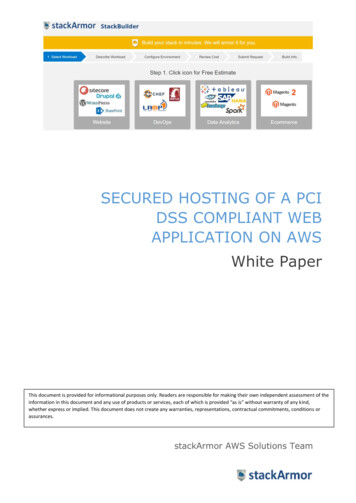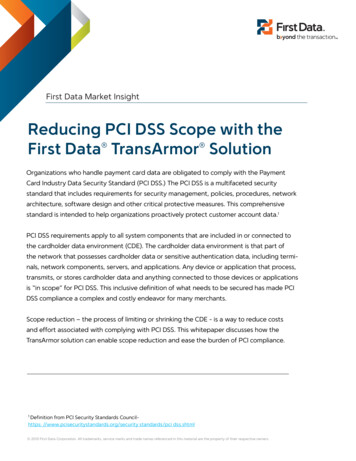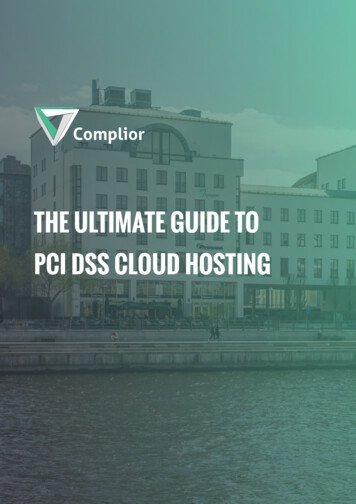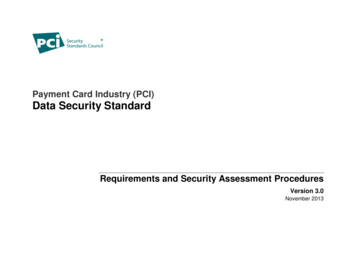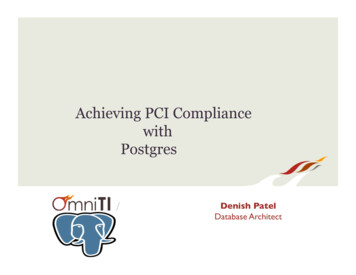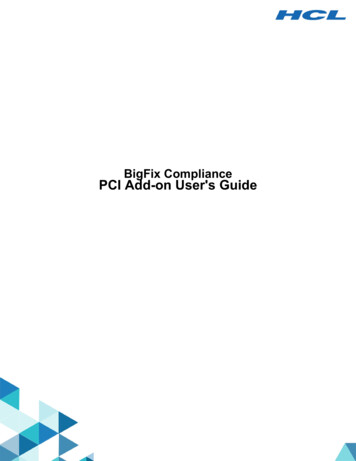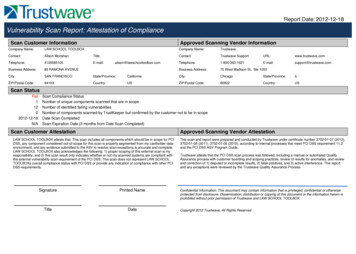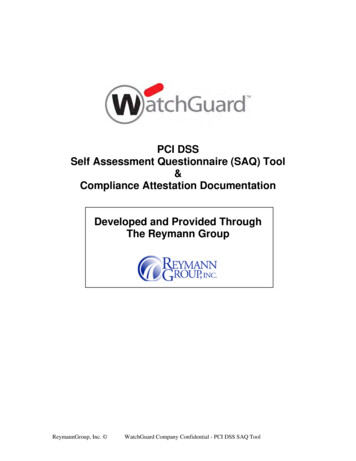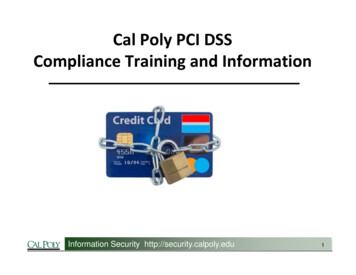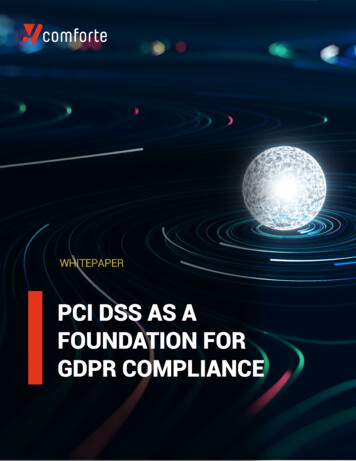
Transcription
WHITEPAPERPCI DSS AS AFOUNDATION FORGDPR COMPLIANCE comforte AG 20210
Table of ContentsINTRODUCTION . 2DEFINITIONS OF CARDHOLDER DATA AND PERSONAL DATA. 3SECURING DATA AT REST AND DATA IN MOTION. 4MAPPING OUT DATA STORES . 6DATA PROTECTION RISK AND IMPACT ASSESSMENTS . 7DATA MINIMISATION AND REDUCTION OF SCOPE . 8LIMITING ACCESS .10LOGGING ACCESS.10LIABILITY AND OBLIGATIONS IN CASE OF A DATA BREACH .12CONCLUSION .13 comforte AG 20211 14
INTRODUCTIONThe online business world is dynamic and expanding rapidly, and businesses as well as legislators have beenstruggling to keep up. As more and more consumers become accustomed to online services, a greateramount of their data is being stored, transmitted and processed digitally. Concerns over data securityprompted the Payment Card Industry (PCI) to publish a consolidated Data Security Standard (DSS) to protectcardholder data in 2004. This replaced the standards that were previously set on an individual basis by eachpayment card provider. Since then, the PCI DSS has been revised and updated continually to reflect thechanging online business environment and the threats to cardholder data.Within the European Union, not only cardholder data but the protection of personal data in general has beena priority for many years. The latest iteration of EU legislation regarding personal data is the General DataProtection Regulation (GDPR), which supersedes the Data Protection Directive (DPD) of 1995. The GDPRapplies to many more organisations than the DPD and the repercussions for non-compliance are significantlymore severe.The GDPR requires all organisations handling any personal data of individuals residing in the EU to bolstertheir data management and security strategy. This includes organisations based outside of the EU thathandle data of EU residents.Penalties for non-compliance can be as high as 4% of global annual revenue or20 million, whichever is higher. Many of the organisations affected by this new regulation have still notachieved GDPR compliance. According to the Cloud Security Alliance’s GDPR Preparation and ChallengesSurvey Report, just a few weeks before the deadline on 25 May 2018, 83% of companies did not feel veryprepared for GDPR .The GDPR requires all organisations handling any personaldata of individuals residing in the EU to bolster their datamanagement and security strategy. This includesorganisations based outside of the EU that handle data of EUresidents. comforte AG 20212 14
For companies striving to become GDPR compliant, the PCI DSS can used as a useful point of reference fora number of GDPR requirements. While far from identical, there are certain areas where the PCI DSS andGDPR overlap. Whether your organisation is already PCI compliant or moving in that direction, the technologies and processes required for PCI compliance can be used as a framework for GDPR compliance.Depending upon your company’s status of PCI compliance, this overlap makes it possible to either fulfilcertain requirements of each regulation simultaneously or to leverage existing PCI compliant technology andprocesses and apply them to the GDPR’s definition of personal data. This document provides insight on howto take advantage of this overlap as a part of your overall data security strategy.»According to Gartner, “on 25 May 2018, less than 50% ofall organisations impacted will fully comply with the*NOTE: This document, while intended toGDPR.” Furthermore, “before 2020, we will have alreadyinform our clients about the current dataseen a multimillion Euro regulatory sanction for GDPRprivacy and security challenges experiencedby IT companies in the global marketplace, isnoncompliance.” Gartner, Inc., research note GDPRin no way intended to provide legal advice orClarity: 19 Frequently Asked Questions Answered, Bartto endorse a specific course of action.Willemsen, 29 August 2017*DEFINITIONS OF CARDHOLDER DATA AND PERSONALDATAAccording to the PCI DSS, cardholder data is a Primary Account Number (PAN) either by itself or acombination of other data elements attached to it, such as the cardholder name, expiration data and servicecode. If those elements cannot be traced back to a specific PAN, then they are not considered cardholderdata as far as the PCI DSS is concerned. A PAN must be present for any given data to be consideredcardholder data. comforte AG 20213 14
Personal data according to Article 4(1) of the GDPR is significantly broader in scope and includes all of theabove data elements and many more, either as individual elements or a combination of multiple data types.Put simply, the GDPR defines personal data as any information that could possibly reveal the identity of ahuman being. This includes concrete information such as names, ID numbers and location data, but it alsoencompasses more abstract elements such as physical description and biometric data, physiology,genealogy, social identity, mental status and economic status.When developing a GDPR compliant data security strategy, many of the technology, processes and policiesfor protecting cardholder data can also be applied to personal data. The following sections explore the manyscenarios in which this is possible.The technologies and process required for PCI compliance can be usedas a framework for GDPR compliance.SECURING DATA AT REST AND DATA IN MOTIONBoth the GDPR and PCI DSS require some form of cryptography to protect data at rest and data in motion.That includes stored data as well as data being transmitted or processed. Cryptography ensures that even ifan unauthorised entity gains access to sensitive data, that data will be in a state that has no exploitablevalue. There are a number of options for securing data with methods that satisfy both regulations.Encryption can pseudonymise data by replacing every element with an algorithmically determined cipherresulting in a completely unrecognisable series of numbers, letters and characters. While this can be aneffective method of protecting data, encryption changes the length and type of the data into formats thatare not always compatible with intermediate systems. Encrypting and decrypting also require a significantamount of computational resources which can affect throughput. Tokenisation is an equally effective, yetmore versatile method that replaces sensitive data with non-sensitive substitutes without changing the typeor length of the data. This can be a critical difference because certain intermediate systems such asdatabases are only capable of reading specific data types and lengths. comforte AG 20214 14
Furthermore, tokens require significantly less computational resources to process. Specific data is kept fullor partially visible for business functions such as processing and analytics while sensitive information iskept hidden. Tokenised data can therefore be processed much more efficiently, which reduces the strain onsystem resources. This is a key advantage in systems that rely on high performance.The PCI DSS Requirement 3.4 stipulates that PANs must be unreadable anywhere they are stored. Itspecifies that data at rest can be protected with tokenisation, truncation, one-way hashes of the entire PANor encryption with proper key management. Requirement 4 calls for similar measures to protect data beingtransmitted over public networks.These requirements are nearly identical to Article 32 of the GDPR, which calls for “pseudonymisation andencryption of personal data whether in storage, transmitted or otherwise processed”. Given the definitionof pseudonymisation as described in Article 4(5), personal data must be stored and processed in such away that it cannot be traced back to a specific data subject without the use of tightly secured additionalinformation. This can be achieved with any of the methods mentioned in PCI DSS Requirement 3.4.SECURINGDATA comforte AG 20215 14
MAPPING OUT DATA STORESIn order to effectively secure personal data or cardholder data, companies must identify all places wherethat data is stored. This is a necessary first step in complying with many PCI and GDPR requirements suchas carrying out regular risk assessments, logging access and data disposal. In the event of a breach,knowing where data is stored will also facilitate investigations into what data stores were compromised andhow.Additionally, GDPR Article 17 guarantees the right to erasure or the “right to be forgotten”, which means thatdata subjects can request that all of their personal data be deleted. This can only be done properly if acompany knows exactly how many copies of the data in question exist and where they are stored.DATAPROTECTION comforte AG 20216 14
DATA PROTECTION RISK AND IMPACT ASSESSMENTSThe threats to personal data and cardholder data are changing constantly. In order to keep up,organisations must conduct regular reviews to gauge how well personal data is protected. In addition,whenever an organisation undergoes major changes that might affect data security policy and processes,such as mergers and acquisitions, relocation or the adoption of new data processing systems, riskassessments must be carried out. These common sense policies are required by both the PCI DSS and theGDPR.The GDPR identifies a broad range of processing operations that are subject to review while the PCI DSSdefines a timeframe and suggests specific risk assessment methodologies. The risk assessmentframework defined by the PCI DSS provides clearer and more specific answers to the questions of how toconduct reviews and how often. Organisations that are already equipped for PCI mandated riskassessments could apply the same methodologies to the additional processing operations specified by theGDPR.Organisations that are already equipped for PCImandated risk assessments could apply the samemethodologies to the additional processingoperations specified by the GDPR. comforte AG 20217 14
GDPR Article 35 requires organisations carry out a data protection impact assessment (DPIA) forprocessing operations that are “likely to result in a high risk to the rights and freedoms of natural persons”.In October 2017, the EU Article 29 Working Party (WP29) published their revised guidelines defining whatprocessing activities may pose such a risk and therefore necessitate a DPIA. That would include anyprocessing activities that fulfil at least two and in some cases just one of the following criteria:Automated decisionEvaluation or scoringmaking with legal orSystematic monitoringsimilar significant effectSensitive data or data of aData processed on aMatching or combininghighly personal naturelarge scaledatasetsInnovative use orWhen the processingData concerning vulnerableapplying newprevents data subjects fromdata subjectstechnological orexercising a right or using aorganisational solutionsservice or a contractFor instances where it is not clear whether a DPIA is necessary, it is advisable to err on the side of caution.Also note that the European Data Protection Board (EDPB), referred to throughout the GDPR as “the Board”,replaces the WP29.DATA MINIMISATION AND REDUCTION OF SCOPEBoth the PCI and GDPR provide guidelines for reducing the amount of data being processed. This has theadvantage of minimising risk and reducing the time, effort and costs associated with securing excess data.PCI DSS Requirement 3.1 stipulates that cardholder data storage should be kept to a minimum andrecommends a number of methods for minimising data storage. These include setting retention timesbased on legal, regulatory or business requirements; defining specific requirements for retaining cardholder comforte AG 20218 14
data; defining processes for secure deletion of data and scheduling a quarterly review to identify andsecurely delete cardholder data that is no longer needed.The GDPR mandates a very similar policy with regard to personal data in Article 25. The controller isobligated to “implement data-protection principles such as data minimisation” and “only personal datawhich are necessary for each specific purpose of the processing [may be] processed. That obligationapplies to the amount of personal data collected, the extent of their processing, the period of their storageand their accessibility”. As a result, the methods and standards for limiting cardholder data storage assuggested by PCI can be applied to personal data in order to achieve compliance with GDPR Article 25.In addition to minimising the amount of sensitive data being processed and stored, Article 25 also mentionslimiting accessibility, which is covered in the following section.DATAMINIMISATION comforte AG 20219 14
LIMITING ACCESSLimiting access to sensitive data is a key component of the GDPR and PCI DSS. The advantage of this kindof policy is twofold. First, every account with access to sensitive data is a possible attack vector andtherefore limiting access is analogous to limiting vulnerability. Even if users are properly trained in handlingsensitive data, their credentials have the potential to be compromised by malicious actors so it is advisableto only grant access to those who absolutely need it. Second, limiting access narrows down the list ofpossible sources during an investigation should a breach ever occur. As such, it can be seen as both aproactive and retroactive security measure.PCI DSS Requirements 7 through 9 describe how to limit access to cardholder data. This includes restrictingaccess to only those with a specific business need, authenticating access to system components andcontrolling physical access to cardholder data touchpoints. Each requirement delineates a number ofconcrete measures to take in order to fulfil them effectively.According to Requirement 7, access needs and levels of privilege such as user or admin should bedetermined for each unique user ID and, by default, only the least amount of privilege required to fulfil agiven role should be granted to a given user. Requirement 8 describes how to maintain the integrity of log-incredentials, such as user account management, standards for passwords and multi-factor authentication.While 7 and 8 deal with digital access, Requirement 9 concerns physical access management. This includesmeasures such as door locks, ID badges, video surveillance in accordance with local law, etc.PCI Requirements 7 through 9 can be interpreted as a set of best practices to follow when determining howto limit access as required by GDPR Article 25(2). These checks are prerequisites to the obligation to logaccess to sensitive data.LOGGING ACCESSIn addition to the accessibility limitations referenced above, logging access to sensitive data is anotherindispensable part of any data security strategy. Access logs are useful for proactively detecting potentiallymalicious activity and, if a breach does occur, they are essential to investigations to determine the source ofthe breach. GDPR Article 30 requires that both processors and controllers keep records of all processingactivities and specifies what information those records must contain. This includes the name of the comforte AG 202110 14
processor or controller, the name of the DPO, the categories of the data subjects and personal data, thenames of any recipients, a timeline for erasure and a description of the data safety measures taken.These requirements overlap to a large extent with PCI Requirement 10: “track and monitor all access tonetwork resources and cardholder data”. This requirement calls for audit trails that can answer who, what,when, where and how at a moment’s notice regarding any access to cardholder data over the past threemonths. Furthermore, the PCI DSS recommends retaining logs for at least a year because in some cases abreach might not detected until months after the fact. Requirement 10 also lays out a framework forsecuring the integrity of access logs, such as time synchronisation of network systems, strictly controllingany alterations to records, a yearlong retention period and a schedule for regular reviews of logs andincidents.HOW TO AVOID ADATA BREACH comforte AG 202111 14
LIABILITY AND OBLIGATIONS IN CASE OF A DATABREACHIn the event of a breach, organisations will not necessarily be penalised, but they will have to demonstratethat their security apparatus was up to par and that they responded accordingly upon discovering thebreach. Additionally, organisations are obligated to report any breaches of sensitive data to the appropriateparties in a timely manner. Failing to do so is what can result in considerable penalties. If the sensitive datainvolved in the breach was protected with the appropriate measures, such as tokenisation or encryption,then it is not necessary to report it.LIABILITYOBLIGATIONS comforte AG 202112 14
The PCI DSS requires organisations to come up with an incident response plan ahead of time. If a breachoccurs, the effected organisation should notify affected payment card brands, banks and any other thirdparties with whom the organisation has a contractual requirement to notify. Contact information for all ofthese parties should be updated on a regular basis.For such scenarios, the definition of “appropriate authorities” varies between the GDPR and the PCI DSS.According to Article 33, in the event of a breach of personal data, the Supervisory Authority of the respectiveMember State must be notified within 72 hours. In addition, Article 34 requires that the affected datasubjects be informed as well. This can be done individually or, if individual communication is not feasible,the breach must be announced publicly.The obligation to report breaches is much stricter under the GDPR in terms of who to contact and when. Forexample, some organisations may find it wiser to report suspected breaches to the Supervisory Authoritybefore they have been verified so as to avoid violating the 72 hour disclosure rule. Whether a breach hasbeen confirmed or not, if the decision is made to report, an incident response plan as described in PCI DSSRequirement 12.10 can be used to prepare an organisation to act quickly and accordingly.CONCLUSIONThe risks to personal and cardholder data are many. Together, the GDPR and PCI DSS provide a clearroadmap on how organisations can most effectively protect that data. In order to develop and maintain aneffective data security strategy, these regulations should not be seen as just a burden, but rather as astandard to strive for.Since these regulations overlap in many ways, PCI compliant organisations have a head start in becomingGDPR compliant and any organisation, including those who are not PCI compliant, can use PCI DSS forinspiration on how to interpret some of the more vague aspects of the GDPR. comforte AG 202113 14
This document is not intended as legal advice or to recommend any specific course of action.Always consult with your legal counsel when determining the legally binding obligations of any regulation or contract.References:Cloud Security Alliance. (2018, April 17). CSA Research News.Retrieved from rt/This document may not be modified or translated without the prior written consent of the Cloud Security Alliance. This document and its authorized translations may be copiedand furnished to others, and, in this case, must be provided free of charge (except for compensation for the cost of duplication, if any). This notice and references to the CloudSecurity Alliance in this document must remain on all versions, copies, translations, abstracts, extracts, or summaries of the document. Works that comment on, or explain thisdocument, or assist in its implementation may be prepared, copied, published, and distributed, in whole or in part, without restriction of any kind, provided that the above copyrightnotice and this section are included on all such copies and derivative works. The limited permissions granted above are perpetual and will not be revoked by the Cloud SecurityAlliance or its successors or assigns.This document and the information contained herein are provided on an “AS IS” basis. The Cloud Security Alliance DISCLAIMS ALL WARRANTIES, EXPRESS OR IMPLIED,INCLUDING BUT NOT LIMITED TO ANY WARRANTY OF TITLE, WARRANTY OF NON-INFRINGEMENT OF THIRD PARTY INTELLECTUAL PROPERTY RIGHTS OR ANY IMPLIEDWARRANTIES OF MERCHANTABILITY OR FITNESS FOR A PARTICULAR PURPOSE.European Commission. (2017, October). EU Newsroom. Retrieved fromhttp://ec.europa.eu/newsroom/document.cfm?doc id 47711Gartner, Inc. (2017, August 29). GDPR Clarity: 19 Frequently Asked Questions Answered.www.comforte.com comforte AG 202114 14
a number of GDPR requirements. While far from identical, there are certain areas where the PCI DSS and GDPR overlap. Whether your organisation is already PCI compliant or moving in that direction, the tech-nologies and processes required for PCI compliance can be used as a framework for GDPR compliance.
